The EU’s updated cybersecurity regulations for wireless and IoT devices, effective August 1, 2025, are reshaping compliance requirements under Directive 2014/53/EU. These changes aim to secure networks, protect data, and prevent fraud, but they also bring significant challenges.
With rising costs and complex approval processes, manufacturers face hurdles that could delay market entry. This blog outlines the regulations, challenges, and cost-effective solutions to help you navigate the approval process efficiently.
Understanding EU Cybersecurity Regulations for IoT Devices
The EU’s 2025 regulations require manufacturers to comply with Articles 3.3(d), (e), and (f) of Directive 2014/53/EU, focusing on:
- Secure Network Connectivity (Article 3.3(d)): Devices must ensure reliable and secure connections to protect users from network vulnerabilities.
- Data Protection (Article 3.3(e)): Safeguarding personal and traffic data is now mandatory for all wireless and IoT devices.
- Fraud Prevention (Article 3.3(f)): Devices that process financial transactions must implement robust fraud prevention mechanisms.
Currently, non-harmonized standards require manufacturers to undergo Notified Body assessments, adding cost and complexity to the compliance process.
For a deeper understanding of how these regulations apply to your products, visit our detailed guide: Does Your IoT Equipment Need to Comply with the New EU Cybersecurity Regulations?
Challenges IoT Manufacturers Face
- IoT Security Challenges
Addressing cybersecurity vulnerabilities is critical. Non-compliance increases the risk of delayed market entry and potential penalties. - Wireless Device Compliance Costs
Investments in testing infrastructure and increased reliance on Notified Bodies have driven up certification costs, impacting smaller manufacturers disproportionately. - Market Surveillance Risks
Non-compliance could lead to heightened scrutiny during market surveillance, further delaying product launches.Learn how to mitigate market surveillance risks: Avoiding Market Surveillance Pitfalls.
How IoT Consulting Partners Group Simplifies Compliance
IoT Consulting Partners Group offers comprehensive support to help manufacturers meet these challenges while keeping costs manageable:
- Streamlined Certification Processes: We ensure wireless equipment standards are met efficiently, minimizing unnecessary expenses.
- Expert Guidance: Our team has in-depth experience with IoT compliance requirements, simplifying approval processes through Notified Bodies.
- Customized Solutions: We tailor strategies to your specific product needs, ensuring compliance with radio equipment certification and other regulations.
Act now to secure your device’s compliance before the August 2025 deadline. Contact IoT Consulting Partners Group or schedule a free consultation.

|
Do You Have Questions? Schedule a Free Consultation Now! |
   |
The Importance of Acting Early on Compliance
Proactively addressing IoT regulatory compliance allows manufacturers to:
- Avoid bottlenecks in the radio device approval process caused by high demand for Notified Bodies.
- Strategically plan for affordable cybersecurity services and reduce unnecessary expenses.
- Ensure timely market entry, avoiding delays or penalties during market surveillance.
With the deadline fast approaching, starting early is key to achieving cost-effective IoT solutions and maintaining a competitive edge in the market.
FAQ Section
1. What are the key cybersecurity challenges for IoT devices?
IoT devices must address secure network connectivity, data protection, and fraud prevention as required by Articles 3.3(d), (e), and (f) of Directive 2014/53/EU.
2. How much does compliance cost for wireless devices?
Costs vary depending on device type and assessment routes. IoT Consulting Partners Group provides affordable cybersecurity services tailored to your budget and needs.
3. Why are smaller manufacturers at greater risk?
Smaller manufacturers often lack the resources to handle rising compliance costs, making it essential to work with partners who can streamline the process.
4. Can manufacturers avoid Notified Body assessments?
Not until harmonized standards are adopted. Currently, third-party verification through Notified Bodies is required.
5. What happens if compliance requirements are missed?
Non-compliance can lead to market entry delays, financial penalties, and increased scrutiny during market surveillance activities.
6. How can IoT Consulting Partners reduce certification expenses?
We simplify wireless device compliance and radio equipment certification, offering cost-effective IoT solutions that minimize unnecessary expenses.
By addressing these challenges early and working with IoT Consulting Partners Group, you can confidently navigate the EU’s cybersecurity regulations and ensure your products are market-ready.
   |
Do You Have Questions? Schedule a Free Consultation Now! |
   |


